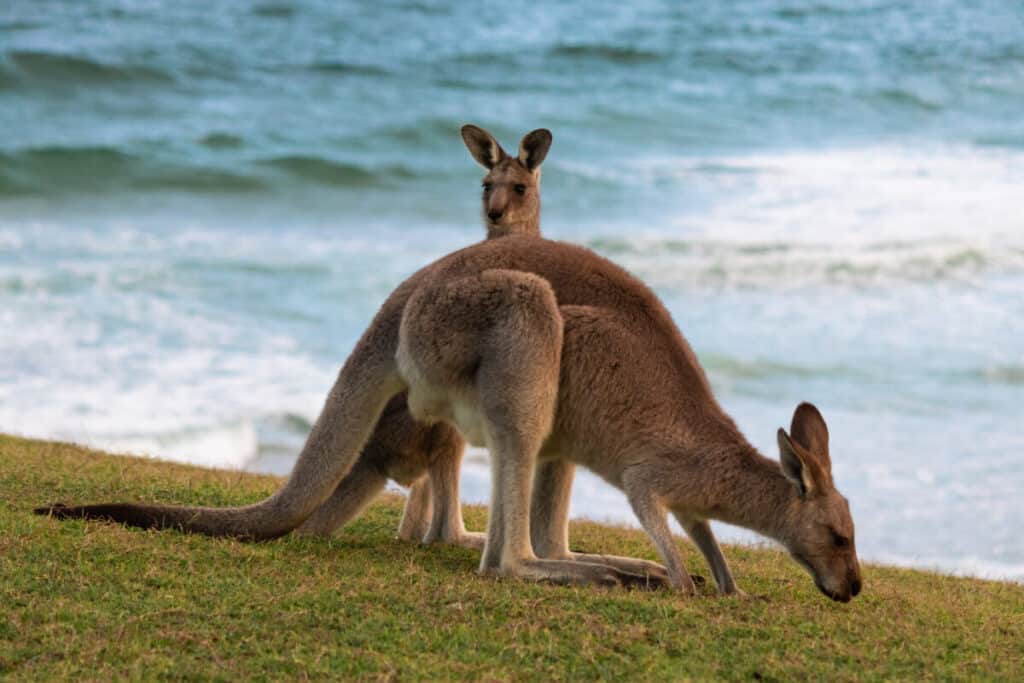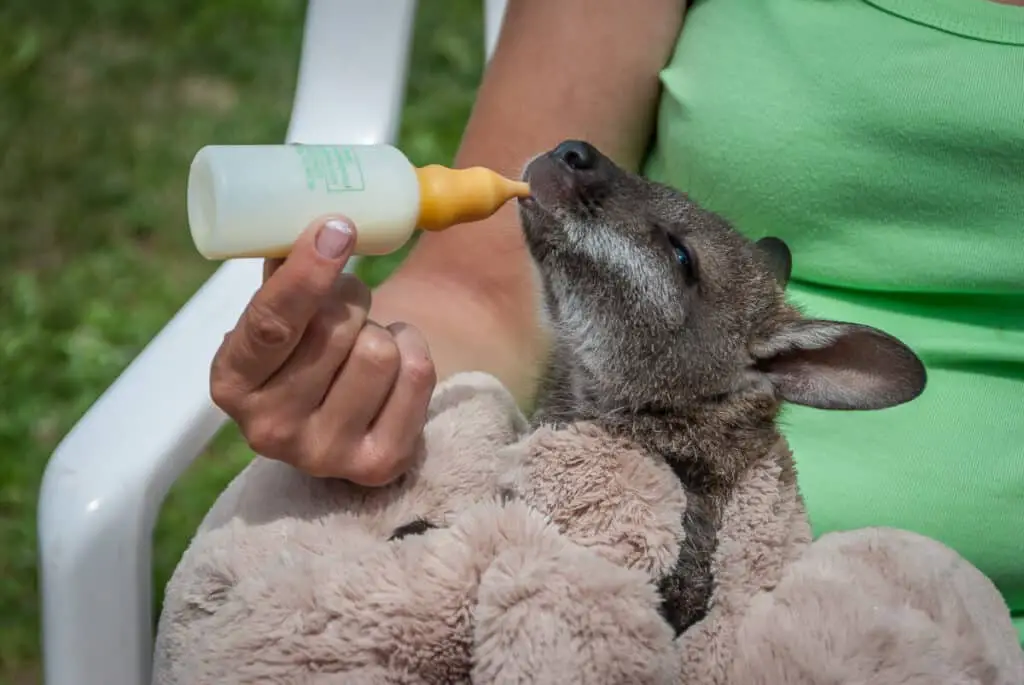Kangaroos are one of the most iconic animals of Australia and are known for their unique hopping ability. These marsupials have a specialized diet that is adapted to their physiological needs, feeding habits, and habitat.
Understanding what kangaroos eat is crucial in determining their ecological niche and how they interact with other species in their ecosystem.
The dietary requirements of kangaroos vary depending on factors such as age, sex, reproductive status, seasonality, and availability of food resources. Kangaroos are primarily herbivores that consume different types of vegetation such as grasses, leaves, shrubs, flowers, fruits, roots, bark, and moss. However, they can also feed on some insects or small vertebrates if plants are scarce.
This article will explore the various aspects of what kangaroos eat by examining their digestive system anatomy and physiology, nutritional needs, feeding strategies, and potential impact on the environment.

Anatomy And Physiology Of Kangaroo Digestive System
The digestive system of a kangaroo is like a well-oiled machine, perfectly adapted to their herbivorous diet.
The process starts in the mouth where they use their powerful teeth and jaws to grind down tough vegetation.
Once swallowed, the food enters the first stomach chamber called the foregut. Here, it mixes with digestive enzymes that help break down plant matter into smaller particles.
From there, the partially digested food moves on to the fermentation chambers located in the hindgut.
These specialized compartments are filled with bacteria and other microorganisms that ferment cellulose and extract nutrients from plant material.
This unique adaptation allows kangaroos to extract more nutrients from fibrous plants than most other herbivores can manage.
As a result, they are able to thrive in harsh environments where food sources are scarce or low in quality.
From Joey to Adult: Exploring the Lifecycle of Kangaroos
Nutritional Requirements Of Kangaroos
Kangaroos have a unique digestive system that allows them to efficiently extract nutrients from their fibrous diet. They possess special enzymes in their stomachs, called foregut fermenters, which break down the tough plant material they consume.
These enzymes allow kangaroos to digest cellulose, hemicellulose, and lignin more effectively than other herbivorous animals. Furthermore, nutrient absorption in kangaroos is also highly efficient due to the presence of large hindguts.
The larger surface area of the hindgut enables more time for fermentation and breakdown of food particles by bacteria before excretion occurs. As such, this process results in greater energy extraction and minimal loss of nutrients through fecal matter.
Overall, these adaptations enable kangaroos to thrive on low-quality vegetation while still meeting their nutritional requirements.
Red Kangaroos’ Predators Exposed: Unveiling the Threats
Types Of Vegetation Kangaroos Consume
Kangaroos, the iconic marsupials of Australia, have a unique grazing pattern that is adapted to their arid environment.
They mostly feed on grasses and shrubs, but also consume leaves, bark, flowers, and fruits when available.
Kangaroo grazing patterns are influenced by factors such as seasonality, rainfall, temperature, and vegetation productivity.
Indigenous perspectives on kangaroo diet reveal a deep understanding of the ecological relationships between the animal and its food sources.
For instance, some Aboriginal communities recognize different subspecies of kangaroos based on their preferred habitats and diets.
The knowledge passed down through generations highlights the importance of sustainable resource management practices that maintain biodiversity and ecosystem health.
Understanding what kangaroos eat not only helps in conservation efforts but also sheds light on the complex interactions within an ecosystem.
Kangaroos’ Predators Revealed: Unmasking the Threats
Feeding Habits Of Kangaroos
Having discussed the types of vegetation that kangaroos consume, it is important to delve into their feeding habits.
Kangaroo foraging behavior varies depending on several factors such as habitat and food availability. Kangaroos are known to be selective feeders, and they can graze on a variety of plants including grasses, shrubs, and trees.
Food preferences of kangaroos vary among different species. For instance, red kangaroos tend to prefer short grasses while eastern grey kangaroos favor taller grasses. Kangaroos also have the ability to adjust their diet according to seasonal changes in vegetation.
During dry seasons when there is a scarcity of food, they may resort to eating bark from trees or even digging up roots. In summary, understanding the feeding behavior of these marsupials provides insight into how they adapt to their environment and survive in the wild without compromising their health or wellbeing.
Kangaroo foraging behavior is influenced by numerous factors which include climate change and human activities like land-use practices and hunting. As herbivores, kangaroos play an essential role in maintaining ecological balance by regulating plant populations through grazing.
Therefore, conservation efforts should aim at preserving suitable habitats that support diverse vegetation cover capable of sustaining these unique animals’ dietary needs. This would ensure that future generations benefit from experiencing these fascinating creatures within their natural habitats whilst promoting biodiversity conservation globally.
Kangaroo Chronicles: Unveiling Their Characteristics
Impact On The Ecosystem
As a keystone species, kangaroos play a significant role in shaping the ecosystem they inhabit.
Their herbivorous diet is primarily composed of grasses and other low-growing vegetation, which influences the distribution and abundance of plant communities.
The grazing patterns of kangaroos also alter soil nutrient levels and water availability, which can have cascading effects on other organisms within the food web.
However, human activities such as habitat destruction and hunting have led to declines in kangaroo populations in many areas.
This has had negative impacts on biodiversity, including reduced genetic diversity within populations and changes in community structure.
Conservation efforts are therefore needed to protect these iconic marsupials and their vital ecological contributions.
These may include measures such as habitat restoration, protected areas, and responsible management practices for kangaroo harvesting.
By taking action to preserve this important species, we can help maintain healthy ecosystems for future generations to enjoy.

Factors Affecting Kangaroo Diet
Climate is one of the primary factors that affects kangaroo diet. Kangaroos are herbivores and eat a variety of plants, including grasses, shrubs, leaves, bark, and fruits.
However, their food availability can be limited by changes in climate patterns such as droughts or floods. During dry seasons with little rain, vegetation becomes scarce and less nutritious for kangaroos to consume.
As a result, they may switch to eating tougher and more fibrous plants which require longer digestion times.
Human intervention also plays a role in shaping kangaroo diets. For example, urbanization and land-use change have led to habitat fragmentation and destruction which limits the availability of natural food sources for kangaroos.
This has forced some populations to adapt by feeding on human-made crops like wheat fields or grazing pastures near cities.
Additionally, humans have introduced non-native plant species which negatively impact native vegetation diversity and quality – further impacting kangaroo diets.
Interactions With Other Species In The Ecosystem
Kangaroos have a significant impact on the ecosystem they inhabit, particularly with regards to their interactions with other species.
As herbivores, kangaroos primarily consume grasses and shrubs. However, they may also browse on leaves, bark, and fruits of trees in times of drought or food shortage. Their grazing activity has been observed to promote plant growth by reducing competition among plants for resources such as water and nutrients.
Additionally, kangaroos can serve as prey for various predators including dingoes, eagles, and crocodiles. The predation pressure exerted by these animals helps regulate the population size of kangaroos within an ecosystem.
In some cases, symbiotic relationships have also been documented between kangaroos and other species such as birds that follow them to feed on insects disturbed by the movement of the marsupials through vegetation. These interactions highlight the important role that kangaroos play in maintaining ecological balance within their habitats.
Conclusion
Kangaroos are unique herbivorous marsupials that inhabit Australia’s grasslands and woodlands. Their digestive system is designed to extract maximum nutrients from the vegetation they consume, which includes grasses, herbs, leaves, bark, and fruits.
The nutritional requirements of kangaroos vary according to age, sex, reproductive status, and environmental conditions. They have developed several feeding habits such as grazing during the cooler hours of the day and regurgitating their food for further digestion.
The impact of kangaroo diet on the ecosystem is significant due to their role in controlling vegetation growth and nutrient cycling. Factors affecting their diet include climate change, habitat loss, competition with livestock for resources, and predation by introduced species.
Interactions between kangaroos and other species in the ecosystem create a complex web of relationships that can affect biodiversity and ecological balance. As an old adage goes: ‘You are what you eat,’ this holds true for kangaroos whose dietary choices influence their health, reproduction success rate as well as survival chances in both captive breeding programs or wildlife habitats.
Therefore efforts must be made to protect these animals’ natural habitats so that they may continue to thrive and contribute positively to our environment.

